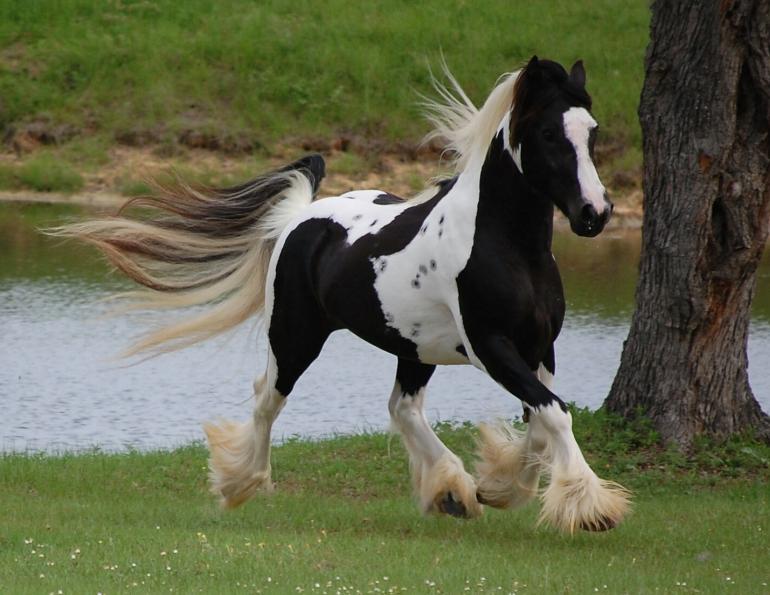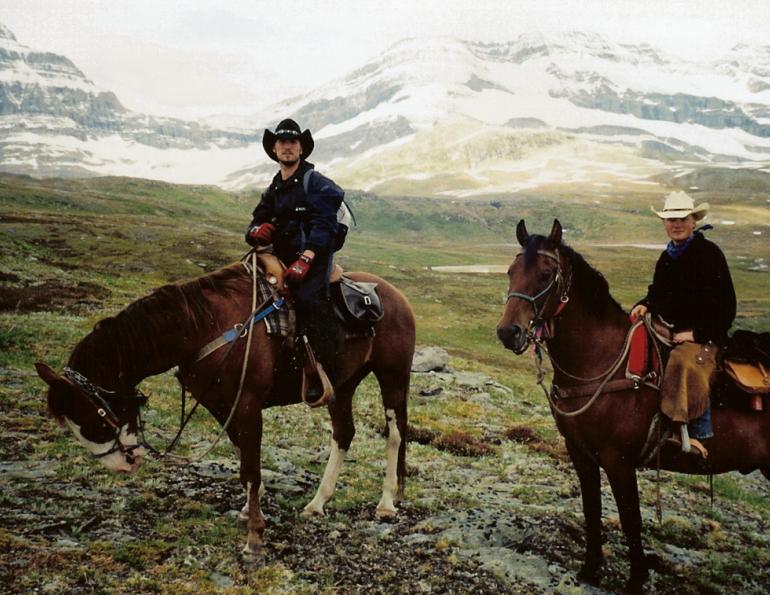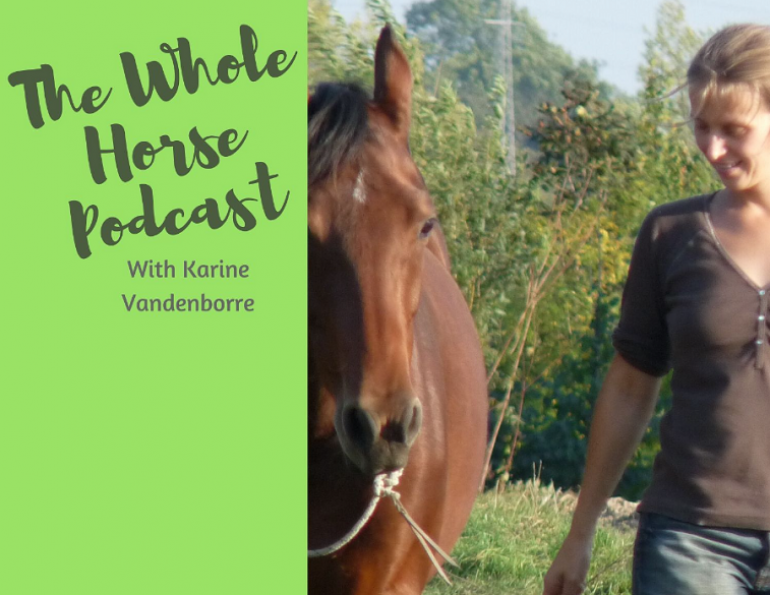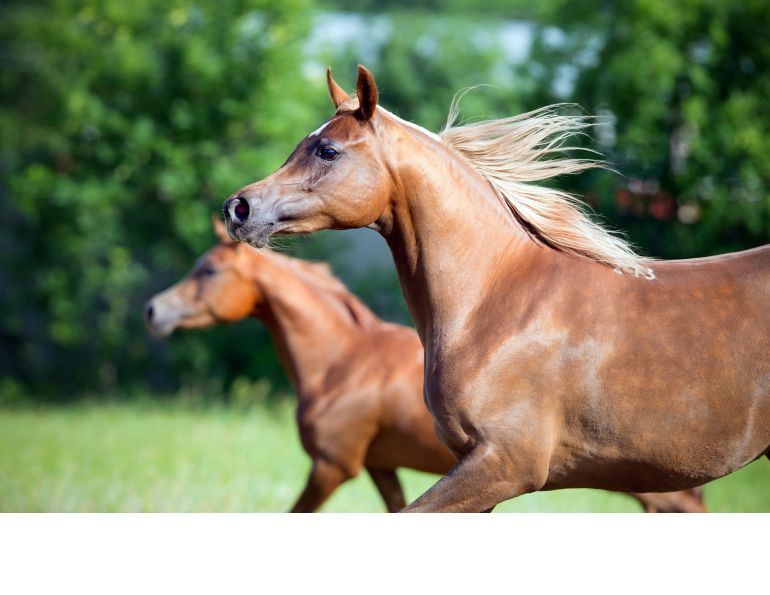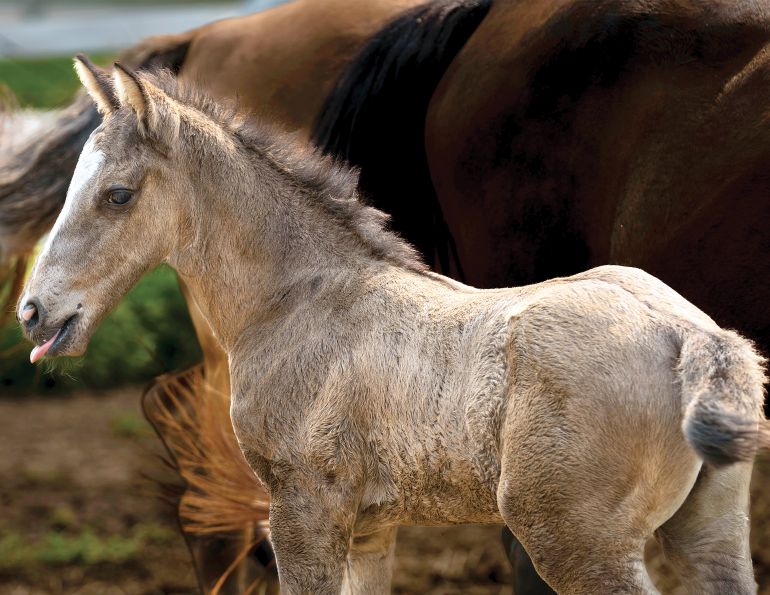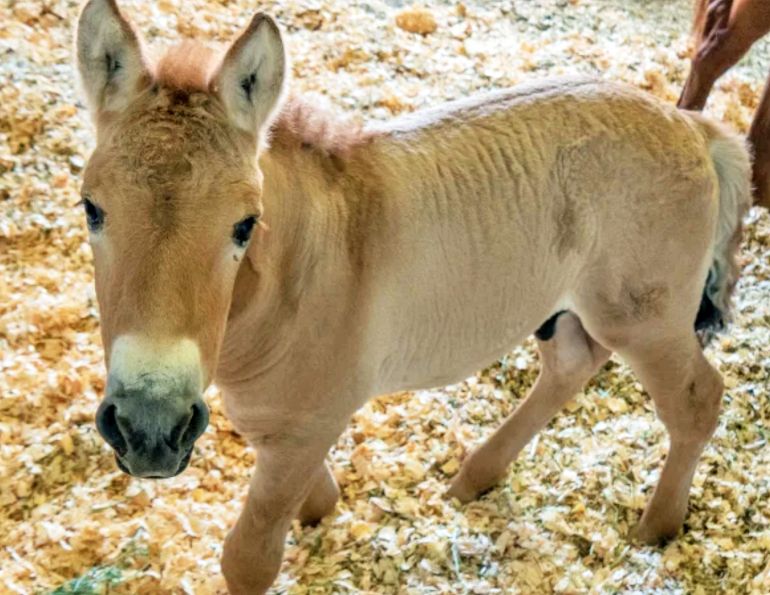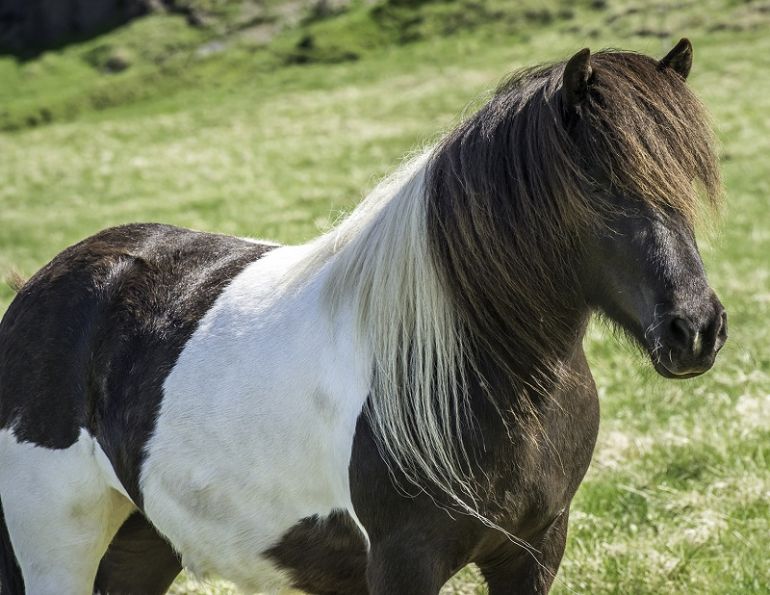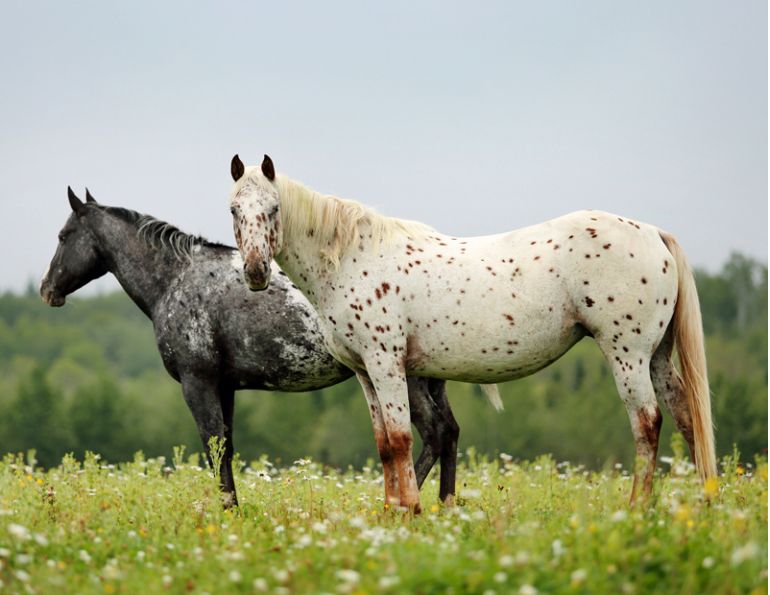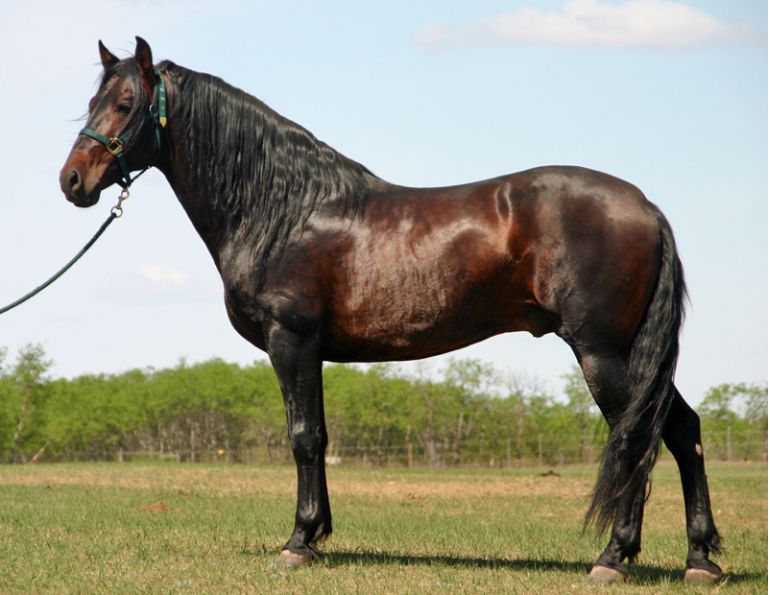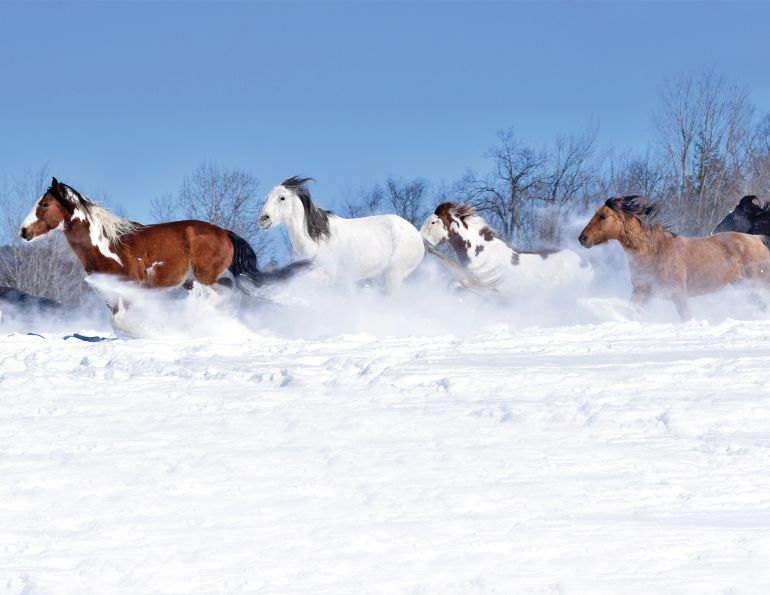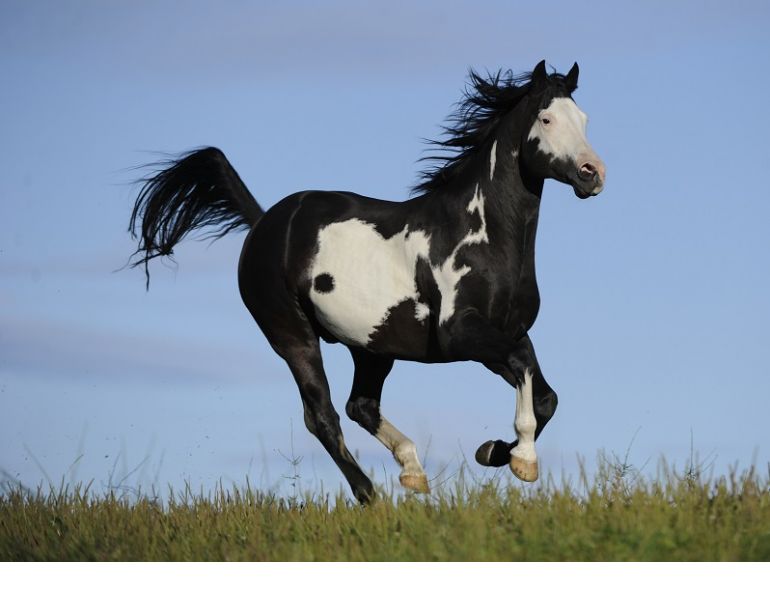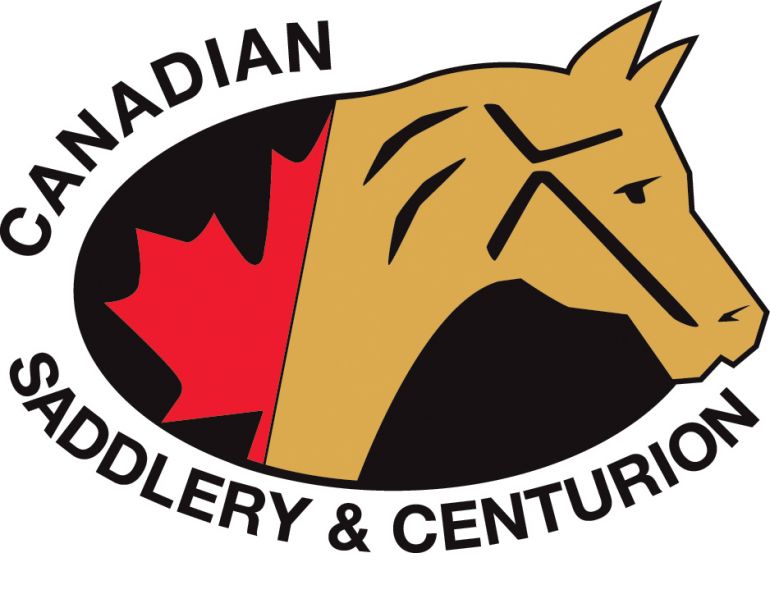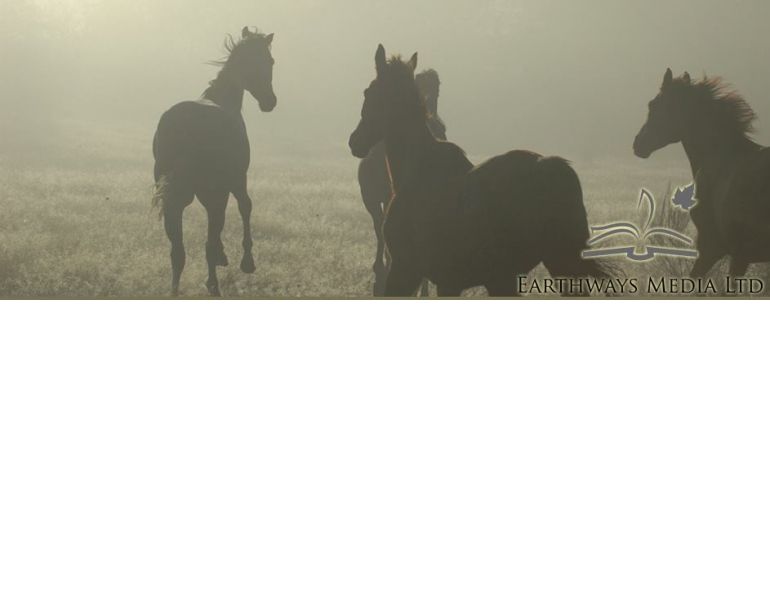By Jess Hallas-Kilcoyne
Like some fantasy creature of legend or a magical steed from a fairy tale come to life, so the Gypsy Vanner Horse seems. Its enormous power and presence, made unintimidating by the gentleness of its nature, adorned with an abundance of flowing mane, tail, and feathers, make it a breed that attracts a crowd of new admirers wherever it goes.
A relatively new breed in North America, the history of the Gypsy Vanner is as romantic as its appearance. The story begins with the Romani people (more frequently called Gypsies) of Great Britain and Ireland, and their desire to breed a horse that fit their vision of the ideal caravan horse to suit their wandering lifestyle. This horse had to possess the physical strength to pull the heavy wagons, or “vardos,” that functioned as portable houses, the hardiness to endure life on the road without shelter or feed beyond whatever patches of grass were available, and the even keeled temperament that would allow them to be safely handled, even by children. A flashy, eye-catching coat was considered a bonus.

Photo: Gabrielle Boiselle; Courtesy of Gypsy Gold
Selective breeding to produce this perfect caravan horse began soon after the end of World War II and mingled the bloodlines of the Shire, Clydesdale, Dales pony, and Friesian. The Romani people’s selective breeding program continues today, more than half a century later, and escaped the notice of the outside world until an American couple travelling in England chanced upon a horse that captured them, heart and soul.
In 1995, while on a business trip, Dennis and Cindy Thompson of Ocala, Florida, were driving through the English countryside when Cindy noticed a unique-looking black and white horse in a distant field. Intrigued, the couple turned the car around and drove back for a closer look.
“We walked up to the fence and the horse came running over to us,” remembers Dennis, “and we instantly fell in love.” So much so that the Thompsons were moved to approach the farmer and inquire about the horse. The farmer introduced them to the stallion’s owner, a Romani man, who invited Dennis and Cindy back to his camp and, later on, the famous Appleby Horse Fair in Cumbria, where thousands of Romani, as well as Scottish Travellers and Irish Travellers, have been gathering annually to buy and sell horses for over 300 years.
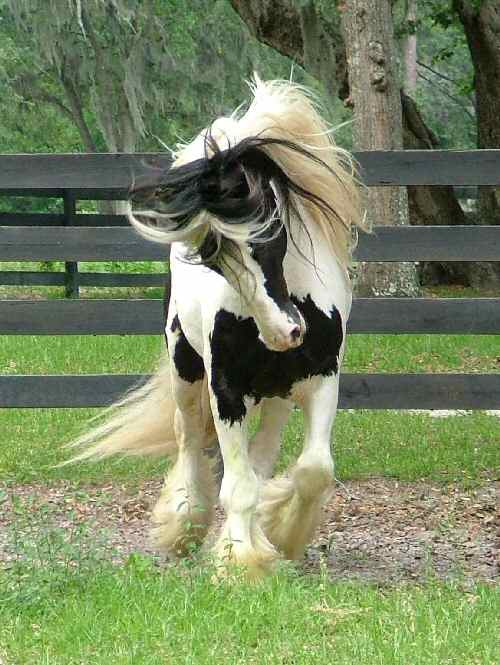
In 1995, Dennis and Cindy Thompson were driving through the English countryside when they happened to notice a striking black and white stallion in a distant field. Less than two years later that same stallion, renamed Cushti Bok, crossed the Atlantic to become the first Gypsy Vanner Horse stallion in North America. Photo: © Mark J. Barrett, www.markjbarrett.com. Courtesy of Gypsy Gold
“We became the first Americans to attend the Gypsy horse fair,” says Dennis. “For the ten days we were at Appleby we studied every horse the Gypsies bought and sold.” The experience only increased the Thompsons’ fascination with the striking black and white stallion they’d seen in the field and his genetic heritage – a fascination that grew into an enduring love and motivated them to immerse themselves in research to learn everything they could about the British Gypsies and their horses.
They discovered that the horses selectively bred to fulfill the Romani vision of the perfect caravan horse only accounted for about 20 percent of the total number of Gypsy-bred horses. The other 80 percent, called “trade horses,” were bred for export to continental Europe or to be used as work horses. These trade horses, of which some are coloured and some not, are somewhat similar in looks to those produced by the selective breeding program, but the infusion of blood of other horse breeds, such as the Connemara and Irish Draught, has given most of them a longer back, less broadness through the chest and hips, a less refined head, and less hair (mane, tail, and feather).
The British Gypsies are more protective of their selectively bred horses, which they take immense pride in, and so, for the most part, the outside world remained unaware of the breed’s existence for decades. These horses didn’t even have an official name to distinguish them as a breed separate from the so-called trade horses; the Romani referred to all their horses as coloured horses or coloured cobs.
During their research, Cindy stumbled across a reference to “the traditional Gypsy vanner” in a book called The Coloured Horse and Pony by English author Edward Hart. The word “vanner,” she discovered, is defined as a horse suitable to pull a caravan. While Cindy was immediately sold on the name Gypsy Vanner Horse, Dennis remained unconvinced. Dennis and Cindy were eager to share the breed with the rest of the world but they agonized over coming up with an appropriate name for the breed that would honour the culture from which it originated.
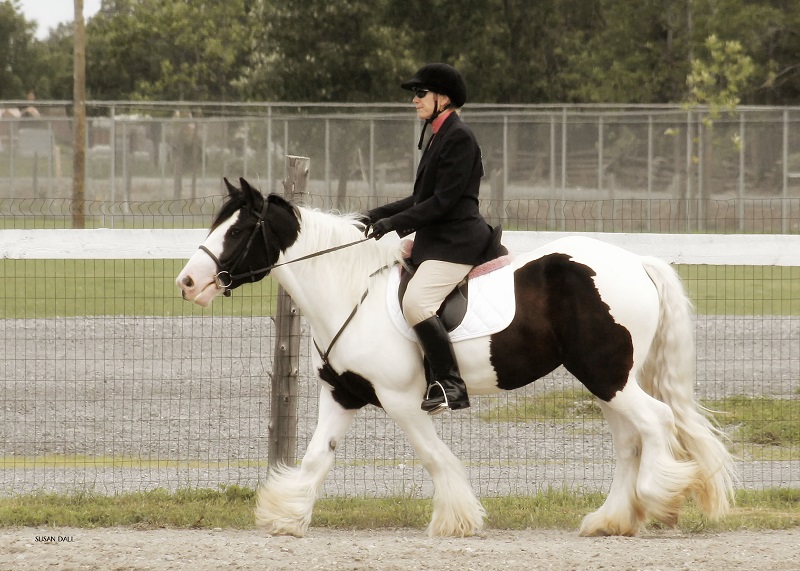
Julia and Dan O’Neill of OnceUponA Farm in Picton, Ontario, brought the first registered Gypsy Vanner Horse into Canada in 2004. Nimue, who was just a four-month-old filly at the time, is a granddaughter of The Gypsy King. Photo courtesy of OnceUponA Farm
“I had a hard time with ‘Gypsy,’ because the word can be used as a cultural slur,” says Dennis. “Our mission was to bring recognition to, and understanding of, one of the world’s most colourful and least understood societies and the horses they so dearly love.” However, any concerns Dennis might have had about cultural sensitivity were put to rest when he and Cindy returned to England to meet once more with the “Gypsy” breeders, who heartily approved of calling the breed the Gypsy Vanner Horse.
With the name of the breed agreed upon, the Gypsy Vanner Horse Society (GVHS) was established in 1996. In November of that year, Dennis and Cindy imported the first two Gypsy Vanner Horses – both fillies – to North America. Less than six months later, the fillies were followed by a stallion, the very same stallion that had caught Cindy’s eye from a field in the distance. In April 1997, this stallion, renamed Cushti Bok, which means “good luck” in the Romani language, became the first registered Gypsy Vanner Horse stallion. The following year, he was joined by a second stallion, who was given the name The Gypsy King, and who would eventually become the breed’s most famous sire in North America.
Together, Cushti Bok and The Gypsy King became the breed’s first two foundation sires in North America, embodying the goals of the GVHS which were:
- To establish the breed with the look envisioned by the Gypsies
- To establish the breed with the genetics that created the look, DNA verified whenever possible
- To establish the breed with the feelings of status and pride that Gypsies feel for their selectively bred horses
- To establish the breed in parallel to the values that Gypsies place on their selectively bred horses
“We discovered a breed of horse and we don’t want to change a thing,” says Dennis. “The Gypsies developed such a wonderful horse; let’s keep the genetics and look they created. That’s the goal.”
The general look of the Gypsy Vanner Horse is defined as, to quote the GVHS Breed Standards, that of “a small draft horse.” Standing anywhere from 13.2 hands to 15.2 hands high, the breed is short coupled and deep chested, with a strong neck, well-sloped shoulder, heavy, powerful hips, and well-muscled hindquarters. Its draft horse-type body is refined by its smaller, “sweeter” head, full and flowing mane and tail, and an abundance of feathering covering the back of its legs from the knee and hock down to cover the hooves. While most people, when they think of a Gypsy Vanner, see a vision of flashy black and white colouring, the Gypsy Vanner Horse is not a colour breed. Therefore, the GVHS considers all colours and patterns acceptable.
The disposition of the Gypsy Vanner Horse is of almost equal importance to its body type.
“Of course they’re beautiful, but the reason I chose them is their temperament and their trainability,” says Kathy Mutti, the owner (with her husband, Dennis Mutti) of Wellington County Gypsy Vanner Horses in Elora, Ontario, and the Executive Director of the GVHS. “They’ve just got such an even keeled, people-loving demeanour. It’s a wonderful horse for children, for a family horse, for the first time horse owner, or for the older rider.”
“It’s the kindest breed of horse I’ve ever known, the most people oriented horse I’ve ever known,” says Dennis Thompson. “They have such good minds, they are very smart, they’re so willing, and they just want to please you.”
Their willingness in particular is credited as the true reason for the versatility of the Gypsy Vanner Horse, which participates successfully in a wide variety of disciplines, including driving, dressage, jumping, eventing, and Western pleasure.
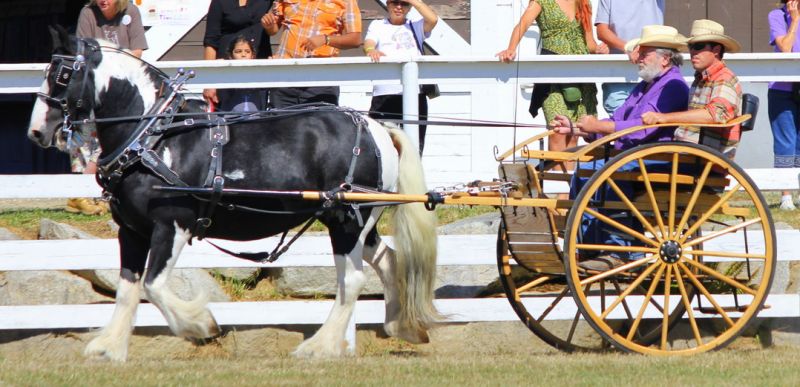
The gentleness and calmness of its nature makes the Gypsy Vanner an excellent horse for children and families. Photo courtesy of Pride of Place Gypsy Horses
“The personality of the breed is that they’ll give anything a try,” says Julia O’Neill, who owns and breeds Gypsy Vanners with her husband, Dan, at their OnceUponA Farm in Picton, Ontario. “Sometimes that try is enough to overcome them not having the perfect jumping technique, for example. They might not have the best physique for jumping but they’re trying hard enough that they’re doing a really good job anyway. I think that is a huge part of their success in so many different disciplines. People show them and excel in English and Western, and I know one lady who showed her Gypsy Vanner in endurance.”
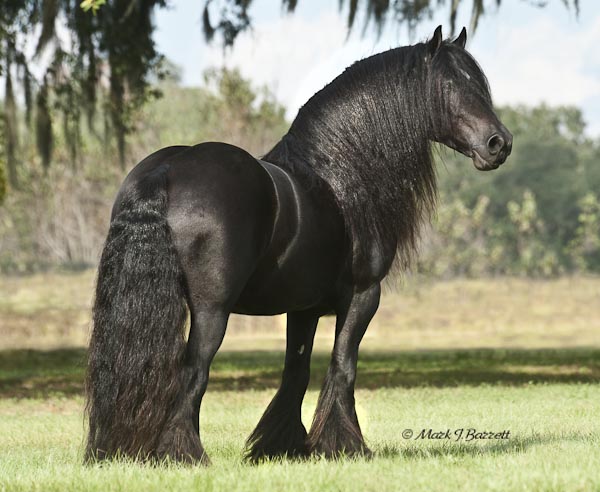
A long silky mane, thick flowing tail, and an abundance of feathers on the lower legs are collectively referred to as “hair,” and are considered a unique and defining characteristic of the Gypsy Vanner. Photo: Mark J. Barrett, www.markjbarrett.com; Courtesy of Gypsy Vanner Ranch
So, clearly looks aren’t everything. However, there’s no denying that the Gypsy Vanner’s stunning appearance is usually what first attracts people to them.
“Oh my god, what a beautiful horse!” was Julia’s reaction the first time she saw a photograph of a Gypsy Vanner in a magazine. “I had no idea what kind of horse he was,” she says, “so I went searching on the internet and found more pictures and eventually learned more about the breed.”
The horse in the photograph turned out to be The Gypsy King, the famous Gypsy Vanner stallion owned by Dennis and Cindy Thompson.
“I cut pictures out of the magazine and put them up but I had no intention of buying one,” says Julia. “I knew how expensive they were. I thought, ‘I’ll never own one, but I can admire them’.”
In 2001, Julia and Dan travelled to Kentucky where they saw Gypsy Vanner Horses in the flesh for the first time.
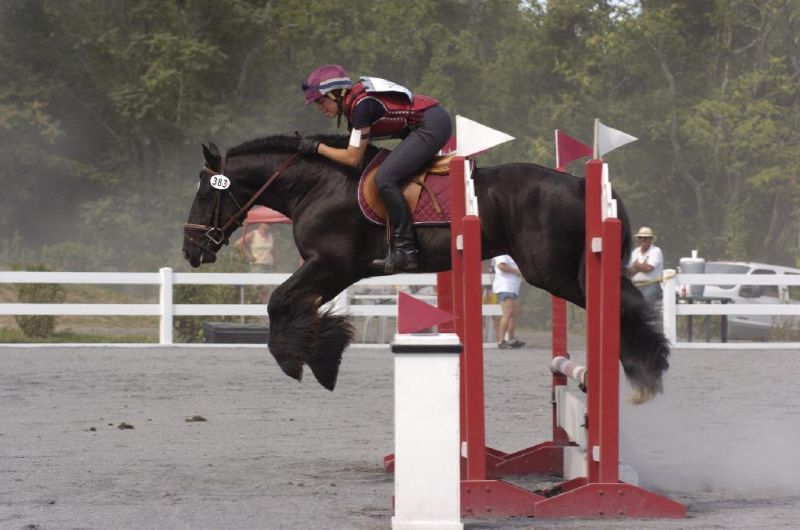
The steady temperament of the Gypsy Vanner, and its willingness to please, allow it to excel in a number of different disciplines. Photo courtesy of Gypsy Gold
“They were just so breathtaking,” remembers Julia, but what really won her over was the Gypsy Vanner’s temperament. “Yes, they’re gorgeous, but they’re also so lovable and good-natured, not flighty or high-spirited. Once we met them in real life, it wasn’t a matter of wanting – we needed one of these horses.”
Three years later, in 2004, Julia and Dan brought the first Gypsy Vanner Horse, a four-month-old filly Nimue, into Canada. Nimue grew to become the foundation mare of the O’Neill’s Gypsy Vanner breeding program at their OnceUponA Farm based in Picton, Ontario.
It wasn’t long before the breed started to catch on with Ontario horse enthusiasts.
“There were six of us altogether,” says Julia. “We all had Gypsy Vanners and we kept bumping into each other at different events. We kept saying, ‘We should start a club’.”
So, in 2007, Julia and Dan, along with Terry and Debra Elder, Sherry Rupke, and Jackie Sherring, became the founding members of the Canadian Gypsy Vanner Horse Club (CGVHC). Today, the CGVHC has grown to include over 30 members, and the club remains affiliated with the GVHS in the U.S., something that was very important to the club’s founders.
“The mission and goal of our club is to promote the [breed], have fun, and also uphold and support the Gypsy Vanner Horse Society,” explains Julia.
In return, the O’Neills report that the GVHS has been incredibly supportive of their efforts to promote the Gypsy Vanner in Canada. The largest by far of these efforts to date occurred in 2011 when Dan, Terry Elder, and fellow Gypsy Vanner enthusiast and CGVHC member Jim Wilson teamed up to organize an event they called Vanner Fair.

The goal of the Gypsy Vanner Horse Society is to preserve the genetics and type of the breed developed and prized by the Romani. Photo: Mark J. Barrett, www.markjbarrett.com; Courtesy of Stillwater Farm
The inaugural Vanner Fair, held at Wilson’s DeerFields Stables just outside of Toronto, was an expo dedicated to the Gypsy Vanner breed, with judged halter and riding classes, breed demonstrations, and shopping all open to the public.
“We thought if 100 people came, that would be amazing,” says Dan. As it turned out, the event attracted nearly 5000 visitors, who were so eager to attend they parked their cars down the sides of the road for miles in each direction and walked the rest of the way.
The incredible success of the first Vanner Fair convinced the organizers that it could not be the last. However, the amount of work required to put on such an event prohibited it from realistically becoming an annual affair. In the end, they settled on a schedule of every other year, and so the second Vanner Fair will be held on the 21st and 22nd of this September at the Orangeville Agricultural Society Event Centre in Orangeville, Ontario. With more than 60 Gypsy Vanners travelling from all over Canada and the U.S. to attend, and the new addition of an Elite Sales Auction, its success is predicted to outshine even the 2011 event.
The impressive accomplishments achieved by the CGVHC in the relatively short time period since its inception speaks volumes about the dedication of its members and their passion for the Gypsy Vanner. Today, approximately ten percent of the nearly 3100 registered Gypsy Vanner Horses are in Canada, and the number of Canadian-owned Gypsy Vanners is on the rise, all thanks to the CGVHC and its founding members who have worked tirelessly to promote the breed in this country.
“We decided it was something that had to be done,” says Dan. “We all knew what we had – it was something special – and we all knew it had to be shown. We just hope it continues the way it’s been going.”
Given all that the Gypsy Vanner Horse has going for it, a bright future for the breed seems like a pretty sure thing.
What’s in a (Gypsy) name?
Gypsy Vanner, Gypsy Cob, Gypsy Horse, Irish Cob, Tinker Horse – there are a variety of names that are used to describe the horses raised by British Gypsies. The British Gypsies themselves referred to all of their horses as coloured horses or coloured cobs, until their breed was discovered and a name was chosen to differentiate their selectively bred horses from the non-breed type of horse they raise.
“The breed is the same no matter what you call it,” says Dennis Thompson, founder of the Gypsy Vanner Horse Society. “But the first name to ever identify horses raised selectively by Gypsies is Gypsy Vanner Horse.”
There are currently four different registries for Gypsy-bred horses in North America: the Gypsy Vanner Horse Society (GVHS), the Gypsy Cob and Drum Horse Association (GCDHA), the Gypsy Horse Association (GHA), and the Gypsy Horse Registry of America (GHRA). While many of the horses in these registries may be similar in type and descended from the same bloodlines, each registry differs slightly in their goal for their breed. Nevertheless, no horses of any one registry are considered to be of superior or inferior quality.
“There are some glorious horses being called Gypsy Cobs that I would love to have in the Gypsy Vanner Horse Society,” says Dennis.
Main Photo: Rebecca McKeever; Courtesy of Custom Chrome Sporthorses - Horse Feathers Aiden, owned by Custom Chrome Sporthorses, is a Gypsy Cob stallion registered with the Traditional Gypsy Cob Association, a registry in England.



